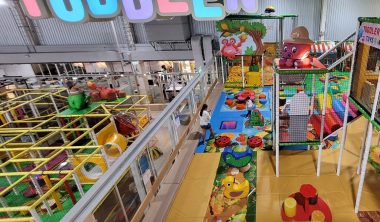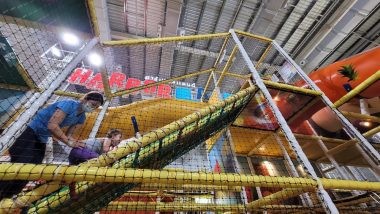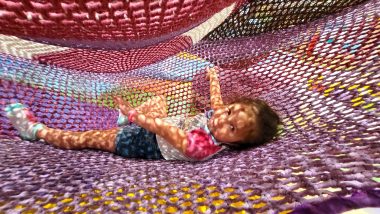The Benefits of Indoor Playgrounds for AADC-deficient Children

One hour of physical therapy cost us $150. Therapy rooms were filled with swings, mats, blocks, and an array of colorful objects. There’s no space in our house to set up our own, and we would probably break the bank trying. However, we could have all the same equipment and more at indoor playgrounds for a fraction of the cost.
An indoor playground does not offer a physical therapist, but with parents or caregivers, there is still so much we can achieve.

An indoor playground offers an inviting environment that is clean and cool. (Photo by Richard E. Poulin III)
An ideal environment to learn through play
A physical therapy session offered an inviting environment of colorful tools, yet our daughter, Rylae-Ann, who lives with aromatic l-amino acid decarboxylase (AADC) deficiency, could still sense that this was hospital-related. Her anxiety would be high. Most of the paid hourlong session was spent coaxing her to start the session happy and keeping her motivated throughout. With each scream and pause, I could feel the money falling out of my pocket.
With the indoor playground, that has never been an issue. The atmosphere is even more child-friendly. With other children happily running around and her favorite songs playing on the speakers, Rylae-Ann enters excitedly and leaves begrudgingly.
It’s the ideal environment to work on exercises that typically don’t thrill her. At no time does she realize we are doing physical therapy. To her, it’s all play. Even if I stop and have her perform a specific exercise, she remains excited.
Cool and clean
Outdoor playgrounds and parks are also an option. They are generally free to enter, unlike an indoor playground, but the admissions price to enter an indoor playground is well worth the cost. Indoor playgrounds are cooled to the temperature of a theater or walk-in refrigerator. This is perfect for AADC-deficient children who may exhibit symptoms such as excessive sweating and temperature instability due to autonomic dysfunction. As you and your child engage in physical activities, you remain cool and comfortable.
Additionally, indoor playgrounds are normally cleaner in my experience, especially since COVID-19. Employees are dedicated to checking children as they enter, providing hand sanitizers, requiring masks, and cleaning equipment profusely. Outdoor parks are at the mercy of Mother Nature providing a rain shower, which is often far from being sterile enough. According to a HomeAdvisor article, “outdoor playground tunnels averaged 1,500 times more bacteria than the indoor playground tunnels.” To put it more descriptively, outdoor playgrounds have more than 52,000 times more bacteria than your toilet seat at home.

Rylae-Ann and her mother play together and enjoy their activity, which supports her physical therapy goals as well. (Photo by Richard E. Poulin III)
So many options for physical therapy
The setting guides you and your child, even if you don’t have specific movements or exercises to work on. I had to do many things for Rylae-Ann before gene therapy, but she still enjoyed going to the playground. After gene therapy, she remembered the activities and was able to make quicker progress because of that.
Ask your physical therapist to give you weekly homework with exercises to perform on your own. We would try to accomplish this at home, but when we did it at indoor playgrounds, it was a much more enjoyable experience.

Judy and Rylae-Ann work on crawling by practicing the movements her physical therapist instructed. (Photo by Richard E. Poulin III)
Improving sensory integration
The first time we took Rylae-Ann to an indoor playground, we only made a few timid steps through the entrance before she started screaming. At the time, we didn’t know much about our daughter’s rare condition, so we left our first trip in fear of triggering a “seizure,” which we now know are oculogyric crises.
We revisited the indoor playground a year later. I wish we didn’t give up so quickly because Rylae-Ann began to enjoy it after a few trips, and eventually, she loved it. Today, she asks us to take her there, and I know I must prepare a speech that I’ll have to patiently recite when I inform her that it’s time to leave.
Sensory integration is a skill we’re reevaluating. We were not too consistent with this paramedical therapy, but now realize that it is crucial to success with other therapies. Playground equipment such as seesaws, slides, swings, trampolines, and bouncy balls will help.

Rylae-Ann enjoys the exciting environment, which also supports sensory integration goals. (Photo by Richard E. Poulin III)
Bring a physical therapist
My wife, Judy, is great at thinking outside the box and problem-solving. Since the price of physical therapy sessions was hard to justify, given the actual amount of time our daughter could get out of it, she came up with the idea of having the physical therapist come to us.
We did the physical therapy sessions at home at first. This was great because it cut down on our travel time and costs. However, in the home environment, Rylae-Ann would be more defiant. It was her room and her toys. We were still wasting session time on just getting her ready.
When Judy arranged for the physical therapist to meet us at the indoor playground, we had an action-packed session. Everyone was happier. The therapist enjoyed it there, and it’s become a regular adventure.
Finding physical therapists to conduct a session outside of their place of practice may not be easy. While you search for someone, continue to bring your homework and enjoy all the entertaining benefits of using an indoor playground to complete your child’s goals. Although this inviting and cool environment offers a safer space for your child, continue to practice good hygiene to minimize exposure to germs and bacteria.
Note: AADC News is strictly a news and information website about the disease. It does not provide medical advice, diagnosis, or treatment. This content is not intended to be a substitute for professional medical advice, diagnosis, or treatment. Always seek the advice of your physician or other qualified health provider with any questions you may have regarding a medical condition. Never disregard professional medical advice or delay in seeking it because of something you have read on this website. The opinions expressed in this column are not those of AADC News or its parent company, BioNews, and are intended to spark discussion about issues pertaining to aromatic l-amino acid decarboxylase deficiency.








Comments